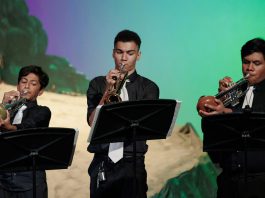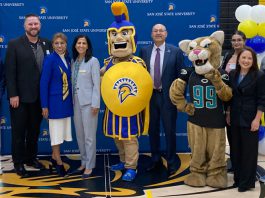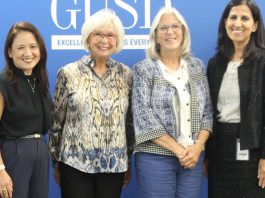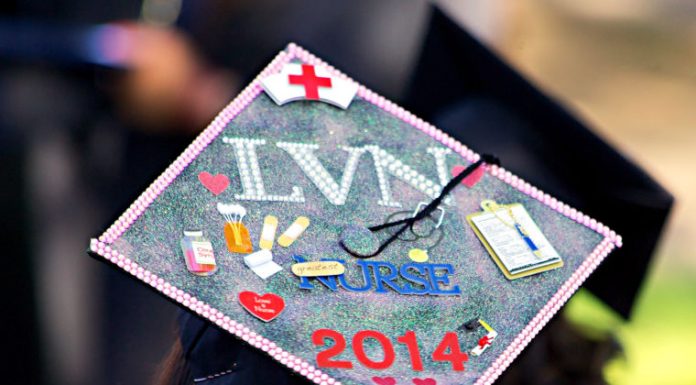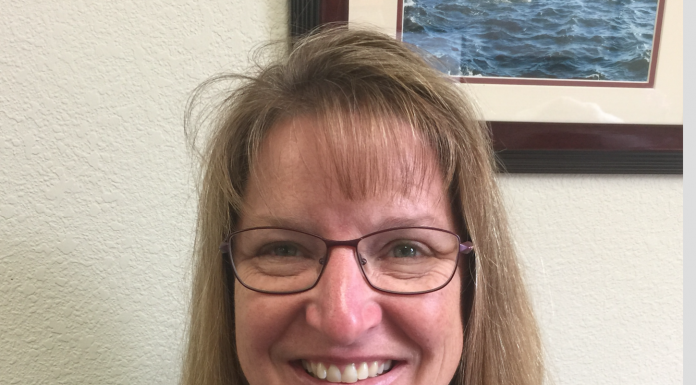How Schools Fared in the Election
The man who dropped out of the Gilroy school board election actually won in more than half of the precincts where ballots were cast. But he is losing in the final count to a pair of incumbents and a newcomer who once headed a school employees union, according to unofficial, semifinal results from the Santa Clara County Registrar of Voters.
Dozens March for Unity in Gilroy Thursday
More than 50 students, parents and members of the community marched nearly two miles through Gilroy to City Hall Thursday at noon to celebrate unity and diversity, things they said were absent in the campaign rhetoric of President-elect Donald J. Trump.The march, organized by the Student Democratic Club at Gavilan College and including local middle and high school students, started at the old CVS store on First Street and continued along Hanna to City Hall, where the peaceful gathering concluded with speakers and a sharing circle on the complex lawn. As they marched they chanted “Unity through diversity,” “The people united will never be divided” “Hey Ho Racism has got to go.” Noshava Afzao, a Gilroy educational consultant who trains teachers, and wore a hijab said she was there with a flag to accent that liberty and justice “was for everyone.” She worried about how the election would affect that. “There’s a lot of disappointment,” she said. “The election is a wake up call. I thought we lived in a country that had made progress and this just shows how much progress we need to make.”As word spread that students at Gavilan College were planning a citywide walkout, school administrators scrambled to inform high school parents.“Gilroy is a lovely little bubble of people who are not always proactive. We want to acknowledge voices and create a coalition,” said Sarah Najar, Vice President of the Gavilan Democratic Club.An email to Christopher High School parents from Principal Paul Winslow said: “FYI High School Parents: Someone is encouraging students to cut school” and “while we definitely support free speech, the right to assemble peacefully, and the right to express opinion” students who missed school to participate would be penalized and not be able to make up work.Lisa Ruiz, a parent of Gilroy students with special needs, said she received a call from the GUSD the night before alerting her that any absence would be considered unexcused, but felt she needed to come anyways.“I got to be here in solidarity with the minorities in the community and to see what we can do to help to unify everyone not be divided and hopefully we can get together in love.”As people gathered in the parking lot, members of the Gilroy Police Department kept an eye on proceedings. Sgt. Wes Stanford had a team of motorcycle officers charged with making sure the demonstrators were safe walking the mile and a half between First Street and City Hall. The department was notified of the march, but organizers didn’t know they would need a permit. “We want to make sure that it’s peaceful, that they are allowed to voice their opinion and whatever views they have and they get to City Hall in a safe fashion.” Stanford said the city has had sporadic marches over the years with the last one he remembers an Occupy Gilroy march of eight people.The well-behaved crowd began their march up First Street - along the sidewalks and stopping at all intersections, using the crosswalks - the sound of honking cars mingling with chants calling for unity.Iris Cueto, 23, a Gavilan biology major, said “The election is making me feel sad, but it’s also making me feel happy to have youth standing up for their rights. It’s nice to see them out here protesting in a peaceful way.” Holding up a coat hanger poster that read, “Never Again,” Summer Diaz, 18, said: “I believe everyone should have their rights. I believe that women should make their own choice and politicians should stay out of women’s rights. “ When the marchers got to City Hall they were offered bottled water by the student organizers who then thanked the crowd for obeying all the traffic laws and the police for “keeping us safe.” Addressing the group, Dr. Enrique Luna, who teaches history at Gavilan, said “we don’t want to be here, but there is a need.” Thanking the march organizers for putting on the event, he said at times he was both laughing and shedding a few tears during the march to city hall. It’s hard to build a community, it’s easy to destroy a community. And we are here to do the hard work.”
Students weigh transfer options at college fair
Gavilan College students searched out their university options Thursday at College Transfer Day.
Know Your Candidates: Mark Good
Mark Good has served on the Gilroy Unified School District Board of Trustees for nearly 12 years and wants to continue to work on education issues with what he believes has been a good and effective team of board colleagues.An attorney and retired Gilroy police sergeant, the incumbent served one four-year term after being first elected in 1996 and did not run in 2000. He ran and won re-election in 2008 and 2012.Good is one of a trio of candidates actively seeking three seats on the GUSD board. A fourth, Paul Nadeau, withdrew from the contest but his name is on the ballot.Nadeau has said he will resign if he is one of the top three vote getters. If that happens, the board will appoint an interim member who may run for election in 2018. It does not have to be the fourth-place finisher.The election comes at a time when trustees are poised to begin $170 million in Measure E building projects, are struggling with somewhat improved but still lackluster test scores and are battling a lawsuit over the districtís decision in 2014 to not fire a teacher now accused of sexual misconduct that targeted students.Good’s and Pace’s profiles are in today’s edition. Candidate BC Doyle’s profile was published last week.Each candidate was asked to respond to three questions. Each was given a 700-word limit but could submit less.Good, 58, is the father and stepfather of five children who went to Gilroy schools. He is a former GUSD board president and supported Measure E.He is a partner and member of the intellectual property, commercial law and real estate litigation practice groups at Terra Law LLP in San Jose.Asked why he is running, he said, “Essentially I think we have turned the district around in a lot of ways. A lot of good things are happening. The board I was on in the ’90s did not work nearly as well as the current board.”Here are the questions posed to each candidate and Good’s responses: DISPATCH: What are some of your specific goals if elected and how would you achieve them? Please discuss your three top priority goals.GOOD: My top three goals are 1) reducing the achievement gap; 2) further reducing the dropout rate; and 3) ensuring the safety of our students and staff.In GUSD, English Language Learners (ELL) represent almost 30 percent of the student population. We have a variety of initiatives in place to help ELLs and are currently in the third year of a master plan for services to English learners. It starts with identification, assessment and proper program placement followed up with appropriate instruction in English language development appropriate to the student. We have made significant improvements in this area and need to continue our forward momentum until the gap is closed.Since my election to the board in 2008, the dropout rate has been reduced from a high point of 26 percent in 2008 to 7.5 percent in 2015. For the first time, we also now have a program administrator who is responsible for school climate and district attendance. Students who do not attend school regularly are much more prone to drop out. This is an area which has to be constantly monitored.When I first ran for the board in 1996, I ran on a platform of increasing school safety. I was compelled to run after a student was fatally stabbed at Gilroy High School. Since that time, the high school campus was closed and security fences have been erected at all schools. Safe school locks have been installed at all secondary schools and additional locking devices were purchased for our elementary schools. We have worked closely with the police department while implementing all of these changes, and for the first time this year, we now have two full-time school resource officers assigned to the district. While some are at or near state averages and others show some improvement, in almost all categories Gilroy’s state test scores are below minimum state standards. This was true in recent and past rounds of tests. What will you do to improve test scores? Fundamentally, the assertion that our test scores “are below minimum state standards” is incorrect. Based on the overall CAASPP data, the district is actually at or above the state average depending on the area.In this second year of the new Smarter Balanced assessment system, scores across the state, and across the country are significantly lower than on previous (paper and pencil) assessments.In 2016, GUSD made growth in both English language arts and math, as compared to 2015 (6 percent point increase in ELA, and a 3 percent point increase in math). The district matched the overall state performance in ELA (49 percent met or exceeded standard) and continues to rank above the state in mathematics (In GUSD 40 percent met or exceeded standard).Santa Clara county tends to score much higher than the state in most academic areas, but much of this is due to the fact that Santa Clara County has very different demographics than much of the state of California.While GUSD’s overall CAASPP scores are below the county average, when looking at subgroup data, Gilroy was at or above the county average in many significant subgroups on the 2016 CAASPP results. In particular, Hispanic students in both ELA and math, and socio-economically disadvantaged students in math. GUSD made growth at all seven grade levels in ELA. GUSD made growth at six of the seven grade levels in mathematics.GUSD compared favorably to neighboring school districts in Monterey, San Benito and Santa Cruz. Gilroy’s public charter school, Gilroy Prep, has consistently been one of the highest scoring schools in the state in key categories and grades tested. Should GP’s methods be mandatory in all GUSD elementary schools and why or why not?Many of GP’s methods are not permitted under the Education Code and/or collective bargaining agreements. We have implemented some of the same instructional practices, for example use of the MOBI, grouping students for small group reading instruction and using some of the same texts. However, there are many differences as we cannot replicate due to inadequate funding and the Education Code. Some major differences that we cannot implement include iPads and other technology in every classroom at a 1:1 ratio for students, highly trained para-professionals that teach in place of teachers which we are not permitted to do (effectively reducing the class size ratio), and a longer school day. There are also two or three instructional coaches just at GP (which is what we have for eight elementary schools). The bottom line is that they receive more funding than we do and do not have to abide by union contracts, providing more flexibility in how they offer programs and services.
Know Your Candidates: James Pace
James Pace is running for a second four-year term on the Gilroy Unified School District Board of Trustees.The father of two GUSD students, a high schooler and a middle schooler, his involvement in education began at the parent club level and as a volunteer at his children’s schools and has continued, he said, as way to give back to the community.Pace is one of three candidates actively seeking three seats on the seven-member board that makes policy for the city’s largest employer.A fourth, Paul Nadeau, withdrew from the contest but his name is on the ballot.Nadeau has said he will resign if he is one of the top three vote getters. If that happens, the board will appoint an interim member who may run for election in 2018. It does not have to be the fourth-place finisher.The election comes at a time when trustees are poised to begin $170 million in Measure E building projects, are struggling with somewhat improved but still lackluster test scores and are battling a lawsuit over the district’s decision in 2014 to not fire a teacher now accused of sexual misconduct that targeted students.Pace’s profile and that of incumbent candidate Mark Good are in today’s edition. Candidate BC Doyle’s profile was published last week.Each candidate was asked to respond to three questions. Each was given a 700-word limit but could submit less.Pace, 44, supported Measure E and is director of future planning for a Morgan Hill real estate development firm.His high school daughter is a student representative to the school board.Asked why he is running, he said, “The district has been very good to my children, they have had great opportunities and experiences and it has been very rewarding for them.”Being on the board, he said, “is a chance to give back and to keep the good things happening and [the district] going forward.”Here are the questions posed to each candidate and Pace’s responses: DISPATCH: What are some of your specific goals if elected and how would you achieve them? Please briefly discuss your three top priority goals.PACE: The number one goal of the District is to increase academic performance, including closing the achievement gap. We need to continue to implement programs proven to build strong academic foundations in students, such as SEAL. In addition, our academic standards are much more rigorous now, so we must ensure that we provide support to ensure student success. I will keep pushing the district forward.It is critical that we keep our fiscal house in order. We are funded seemingly at the whim of the state, and good economic times can change quickly. If Proposition 55 fails or another recession hits, there could be significant cuts to our budget. Since I joined the board, we set a policy to increase rainy day reserves, and we have built that reserve, while simultaneously making our employee packages more competitive, with a balanced budget. I will continue this economic stewardship.Thanks to the people of Gilroy’s commitment to education, Measure E was approved this year. This gives the district the resources necessary to build a new elementary school, renovate South Valley and Brownell Middle Schools, as well as complete other necessary projects throughout the district. If Proposition 51 passes, our local funds will go much further. As a member of the district’s facilities subcommittee, I will work to ensure projects are designed within budget and happen on time. While some are at or near state averages and others show some improvement, in almost all categories Gilroy’s state test scores are below minimum state standards. This was true in recent and past rounds of tests. What will you do to improve test scores?I reject the assertion that the district’s scores are “below minimum state standards.” Our CAASPP scores are at or above the statewide average, and we compare favorably to county averages in a number of significant subgroups. And Gilroy’s scores are growing.Of course, I want our scores to increase more. The district is devoting significant resources to ensuring that students are familiar with the online test format and are able to process the new types of questions, and I support adding needed training and technology for this. A reworking of the math curriculum has happened, a shift to next-generation science standards is coming soon, and a plan for replacing textbooks is being implemented; all these changes and more should cause test scores to continue to climb.However, one test should not be the single measure of the quality of our schools. By many metrics, our district is doing well. The graduation rate is up; the dropout rate is down. Advanced Placement options have doubled in recent years. Meeting University of California entrance requirements is now the default for students. Opportunities abound to be parts of specialized programs, such as the Bioscience Academy, the Spanish/English Dual Immersion program, FFA, gifted and talented programs, and GECA, our highly ranked high school on the Gavilan College campus. The community service requirement is producing young people who understand the value in giving back. There are many career technical education offerings, teaching skills such as metalworking, computer programming, biotechnology, auto maintenance, and culinary arts. We have music options at all levels, including choir from fourth grade up and band from fifth grade up. Students shine in the wonderful theater and visual arts programs. A wide variety of sports and athletic options are available. District programs focused on school climate are creating welcoming environments where students can comfortably be themselves without fear. Teachers and staff are dedicated professionals. Our campuses are safe, secure, and well maintained.I am very proud to be a parent of two Gilroy Unified students, and glad for all the opportunities my children have had. Their experiences have been much more than the score on one test.Gilroy’s public charter school, Gilroy Prep, has consistently been one of the highest scoring schools in the state in key categories and grades tested. Should GP’s methods be mandatory in all GUSD elementary schools and why or why not?GPS has done well on state standardized tests, and their team has been generous with sharing their successful strategies. The district has made regular visits to see their program in action, and one school has a strong working relationship with GPS, where good ideas are passed back and forth. I think this partnership between the district and GPS is valuable, and I hope it continues. Some of their practices are not appropriate or possible at Gilroy Unified schools, for a variety of reasons, including funding, differences in the law, and staffing-related issues.
Big GUSD Grant for College-Bound Students
Gilroy high schoolers are getting a big dose of help to make their college and career dreams come true—and for some, to start thinking about college at all.
Gilroy Students Head to Moscow
It’s here we come, Moscow, for a group of Christopher High School drama students who have been invited to participate in a Shakespeare festival.The teens received an enthusiastic go-ahead from the Gilroy Unified School District Board of Trustees for a 12-day trip that includes a short stay in London and most of 2017 spring break in the land of the Bolshoi and borscht.“It’s an amazing, once-in-a-lifetime opportunity,” CHS principal Paul Winslow told trustees before they voted at their Oct. 6 meeting to approve the March-April field trip.And there wasn’t a nyet among them.“It’s a fabulous and wonderful opportunity for students, I wholeheartedly approve of this,” said trustee Linda Piceno.Colleague Mark Good echoed her sentiments. He added that his son spent three months studying the Stanislavsky acting method in the same Moscow program while earning a Masters of Fine Arts degree from Harvard.Gilroy High School grad Steven Good is now a working actor, singer and musician in Los Angeles. He has performed at the famed Mark Taper Forum and in a feature-length movie for Lifetime television, among other roles.CHS drama director Kate Booth and Gretchen Yoder Schrock, CHS Sister City/International Club Advisor and Spanish teacher, will accompany the 14 teens to London and Russia. Twelve of the students are seniors, one is a junior and one is a sophomore.They are: Jacob Yoder Schrock, Grant Schaper, Jacob Flores Lopez, Owen Emerson, Devan Corini, Brandon Quirke, Annemarie Hayes and Cassidy Andrews.Also traveling to Russia are Samantha Drews, Melinda Colbert, Adaline McCaw, Michaela Hawkins, Brenda O’Connor and Sabine Yoder Schrock.Booth outlined for the board a busy schedule for the eight girls and six boys who auditioned for and won roles in the production being readied for the trip—Shakespeare’s Much Ado About Nothing.“Aside from an extraordinary opportunity to grow as artists and learn history, language, literature and culture from a unique perspective, the trip to Moscow is a true exchange,” she wrote in the 18-page application for student travel.“I am jazzed that they approved us,” she later said. Because the board has denied closer trips, including to Oregon, there was worry that Moscow might not be approved.Booth and Winslow said that rather than seeing the trip as missing four days of instruction, they view it as an opportunity for unique instruction during the spring break and of a nature that can only be had by a cultural exchange.The trip could have been undertaken under the auspices of the theater group’s booster club, but it has more weight and is better for both cities and schools for it to be an officially sanctioned GUSD field trip because “the whole point is to do a student exchange,” Booth said.The host school in Moscow is called the Slavic Anglo-American School Marina. Specializing in graduating students who are fluent in English, it hosts an annual international high school Shakespeare festival with all-English performances.CHS will represent the United States and there’s a Canadian school in the festival, too, Booth said.It’s not the first meeting of the Russian and CHS students. Marina students have visited CHS twice and are keen to create a long-term sister-school relationship, according the field trip supporters.In addition to attending a performance at the famed Globe Theater in London, CHS students in Moscow will participate in theater workshops, shadow their Russian hosts to classes, spend two days at the Moscow Art Theater Conservatory and attend a theater festival and four stage performances.Twenty-two advanced theater students in the Catamount Actor’s Theater (CAT) at Christopher High School auditioned for the slots. The number who can travel was limited by the host’s ability to transport the group around Moscow—their bus is too small for a larger group, Booth said.As it is, CHS will send one more person than they originally thought could be accommodated, she said.Of the performances CHS students will see, one will be either a ballet or opera at the renowned Bolshoi Theater, another will be an avant garde drama and one will be what Booth said provides a “new twist” on Stanislavski.Constantin Stanislavski was a Russian actor and director who created a naturalistic acting technique commonly known as method acting.Trustees said that their overarching concern in reviewing the proposal was student safety.Their approval includes a condition that if the U.S. State Department issues a travel warning for Russia, the trip will be off.Insurance and liability issues also were reviewed and not considered an obstacle. CHS officials assured trustees that students will be responsible for all classroom work missed during their absence.And cost is not an issue, either. By law, Superintendent Debbie Flores pointed out, students cannot be charged for such field trips, assuring equality in access to educational opportunity regardless of ability to pay.In this case, the CAT booster’s club has raised in excess of $27,000 for travel expenses, more than enough for tickets, and the host school will cover many Moscow expenses.Per-student expenses are estimated between $1,500 and $2,500, which includes round-trip airline tickets between $700 and $800, according to the field trip application.
Gilroy school board candidate ends campaign
A candidate has dropped out of the race for three seats on the Gilroy school board but missed the deadline for removal, so his name will be on the ballot.
GUSD Election: What you need to know
Voters will weigh in on whether they like the state of education and local schools when they choose in November from four candidates for three seats on the Gilroy Unified School District Board of Trustees.
Gavilan Classroom with no Walls
Gavilan College students will soon be able to learn outside in a specially designed classroom where rocks are chairs and the surrounding gardens are living, breathing, teaching tools, thanks to a federal STEM (science, technology, engineering and math) grant the school received.



